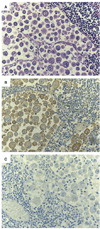Microvesicle-associated tissue factor and Trousseau's syndrome
- PMID: 17239164
- PMCID: PMC3410746
- DOI: 10.1111/j.1538-7836.2006.02301.x
Microvesicle-associated tissue factor and Trousseau's syndrome
Abstract
Background: Trousseau's syndrome is a prothrombotic state associated with malignancy that is poorly understood pathophysiologically.
Methods and results: Here we report studies on the blood of a 55-year-old man with giant-cell lung carcinoma who developed a severe form of Trousseau's syndrome. His clinical course was dominated by an extremely hypercoagulable state. Despite receiving potent antithrombotic therapy, he suffered eleven major arterial and venous thrombotic events over a 5 month period. We examined the patient's blood for tissue factor (TF), the major initiator of coagulation, and found its concentration in his plasma to be forty-one-fold higher than the mean concentration derived from testing of 16 normal individuals.
Conclusion: Almost all of the TF in the patient's plasma was associated with cell-derived microvesicles, likely shed by the cancer cells.
Conflict of interest statement
Figures



Similar articles
-
Pathophysiology of Trousseau's syndrome.Hamostaseologie. 2015;35(1):52-9. doi: 10.5482/HAMO-14-08-0037. Epub 2014 Nov 18. Hamostaseologie. 2015. PMID: 25403091 Review.
-
Trousseau's syndrome associated with tissue factor produced by pulmonary adenocarcinoma.Thorax. 2006 Nov;61(11):1009-10. doi: 10.1136/thx.2004.031492. Thorax. 2006. PMID: 17071837 Free PMC article.
-
Internal jugular venous thrombosis due to Trousseau's syndrome as the presenting feature of metastatic prostate carcinoma: a case report.J Med Case Rep. 2016 Apr 21;10(1):104. doi: 10.1186/s13256-016-0884-9. J Med Case Rep. 2016. PMID: 27097872 Free PMC article.
-
Tissue Factor: An Essential Mediator of Hemostasis and Trigger of Thrombosis.Arterioscler Thromb Vasc Biol. 2018 Apr;38(4):709-725. doi: 10.1161/ATVBAHA.117.309846. Epub 2018 Feb 8. Arterioscler Thromb Vasc Biol. 2018. PMID: 29437578 Review.
-
Tissue Factor Prothrombotic Activity Is Regulated by Integrin-arf6 Trafficking.Arterioscler Thromb Vasc Biol. 2017 Jul;37(7):1323-1331. doi: 10.1161/ATVBAHA.117.309315. Epub 2017 May 11. Arterioscler Thromb Vasc Biol. 2017. PMID: 28495929 Free PMC article.
Cited by
-
Venous thromboembolism and lung cancer: a review.Multidiscip Respir Med. 2015 Sep 15;10(1):28. doi: 10.1186/s40248-015-0021-4. eCollection 2015. Multidiscip Respir Med. 2015. PMID: 26380084 Free PMC article. Review.
-
Tissue factor activity is increased in a combined platelet and microparticle sample from cancer patients.Thromb Res. 2008;122(5):604-9. doi: 10.1016/j.thromres.2007.12.023. Epub 2008 Feb 11. Thromb Res. 2008. PMID: 18262600 Free PMC article.
-
Nanoparticles isolated from blood: a reflection of vesiculability of blood cells during the isolation process.Int J Nanomedicine. 2011;6:2737-48. doi: 10.2147/IJN.S24537. Epub 2011 Nov 8. Int J Nanomedicine. 2011. PMID: 22128248 Free PMC article.
-
Pathogenesis, clinical and laboratory aspects of thrombosis in cancer.J Thromb Thrombolysis. 2007 Aug;24(1):29-38. doi: 10.1007/s11239-007-0028-6. Epub 2007 Mar 31. J Thromb Thrombolysis. 2007. PMID: 17396228 Review.
-
Importance of Standard Treatment in Prognosis of Patients with Ovarian Cancer and Associated Cerebral Infarction.Clin Interv Aging. 2020 Feb 5;15:151-157. doi: 10.2147/CIA.S229236. eCollection 2020. Clin Interv Aging. 2020. PMID: 32103916 Free PMC article.
References
-
- Donati MB. Cancer and thrombosis. Haemostasis. 1994;24:128–131. - PubMed
-
- Trousseau A. Phlegmasia alba dolens. Clinique medicinale de lHotel-Dieu de Paris. London: The New Sydenham Society; 1865.
-
- Bell WR, Starksen NF, Tong S, Porterfield JK. Trousseau’s syndrome. Devastating coagulopathy in the absence of heparin. Am J Med. 1985;79:423–430. - PubMed
-
- Sack GH, Jr, Levin J, Bell WR. Trousseau’s syndrome and other manifestations of chronic disseminated coagulopathy in patients with neoplasms: clinical, pathophysiologic, and therapeutic features. Medicine (Baltimore) 1977;56:1–37. - PubMed
Publication types
MeSH terms
Substances
Grants and funding
LinkOut - more resources
Full Text Sources
Medical
Miscellaneous

